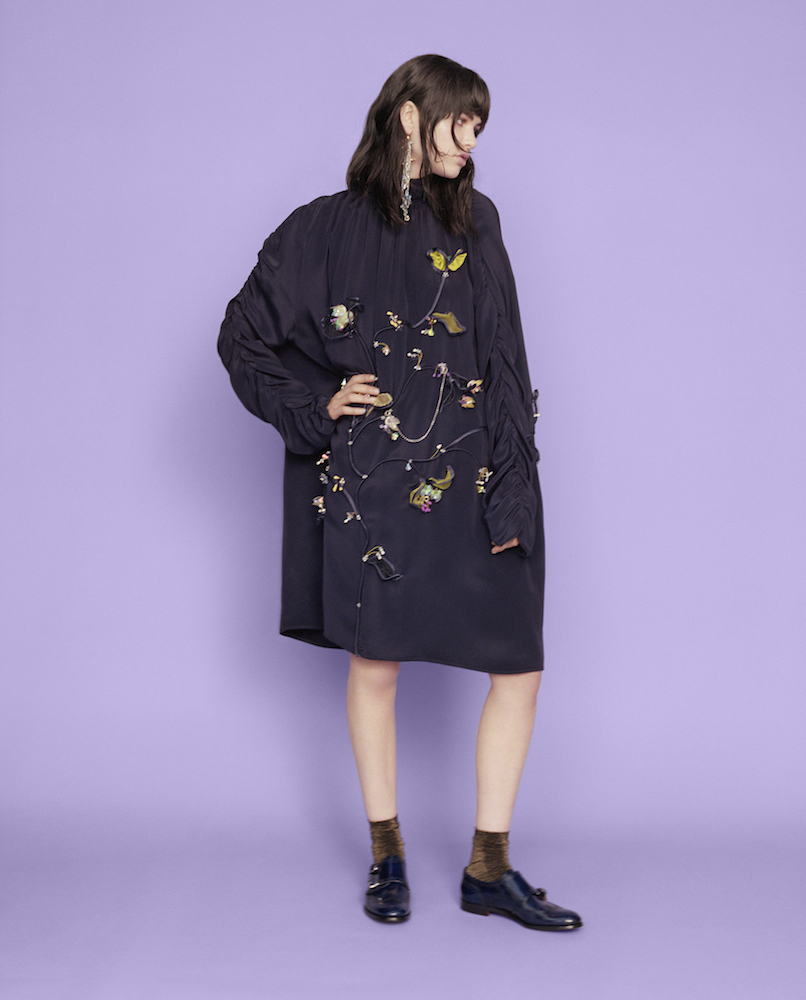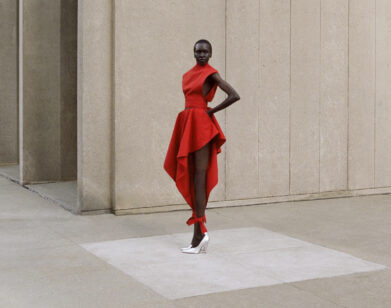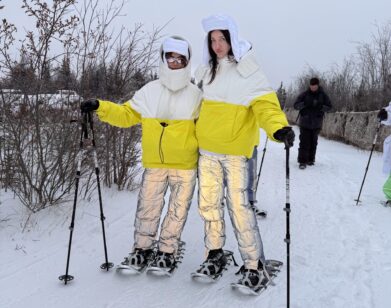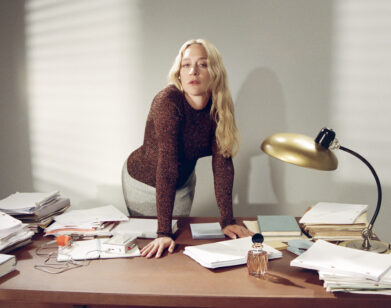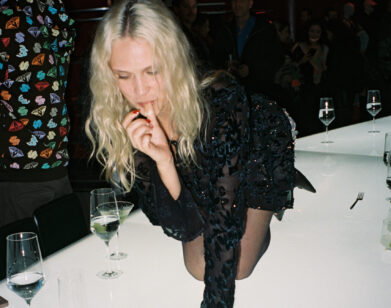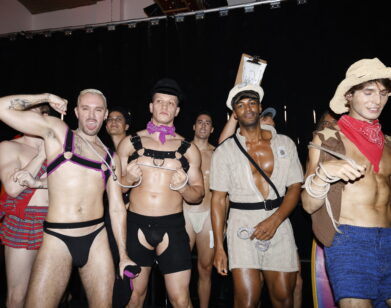The Detail-Oriented Designer
PHOTOS: ROBERT NETHERY. PORTRAIT: HAIR: MIKE HARDING/LALALAND ARTISTS. MAKEUP: VICTORIA BOND FOR MAC COSMETICS/CAREN. MODEL SHOTS: STYLING: MARINA MUÑOZ/LALALAND ARTISTS. HAIR: MAKI TANAKA USING BUMBLE AND BUMBLE. MAKEUP: VICTORIA BOND FOR MAC COSMETICS/CAREN. PHOTO ASSISTANTS: TOM GREEN, JODIE HERBAGE. MODEL: MISHA HART/VIVA LONDON. CASTING: DAVID CHEN.
For her Spring/Summer 2017 collection, A.V. Robertson designer Amie Victoria Robertson envisioned a dreamy wasteland of bright, putrid greens and deep purples. “It’s based on this toxic paradise,” she explains, “a paradise that’s gone bad and become hazardous. Out of it, grow all of these plants that take over, which I developed into embellishments. It’s about these toxic bright colors and distorted silhouettes.”
Presented at London Fashion Week by Fashion East, Robertson’s second-ever runway collection is rich in embroidery, netting, and sheer fabrics. It is the most recent step in a prodigious rise: just three years ago, the Manchester native was a student at Central Saint Martins in London. After a brief but fruitful stint as a design assistant at Marc Jacobs, Robertson started her own, eponymous line a year and a half ago. “I think I would go crazy if I didn’t design,” she tells us. “I’ve never really taken a break, but if I have a weekend off, I miss it so much.”
HOMETOWN: Manchester, U.K.
A PRECOCIOUS YOUTH: I’m the random child in the family. I’m not really like anyone—there’s no one creative—[but] my family has been the most supportive family I could dream of. I knew from the age of 12 that I wanted to go into fashion and study at Central Saint Martins. I got into embroidery when I was probably 13. I was always a creative child; I used to want to be an artist or illustrator when I was younger. I was always writing stories, drawing. When I got into high school, I started textiles, and I almost passed the storytelling onto fashion design. I imagined everything coming to life and I taught myself how to embroider. I was forever buying sequins and Swarovski crystals, and used to stay up all night embroidering. It’s always been a bit of an obsession in how I imagine everything.
REFINING THE CRAFT: My work definitely changed [while I was at Central Saint Martins]. When I started, it was almost costume-like; it was really out there. I think it did tone down slightly, but the main essence of who I am was always there—embroidery, very detailed and specific, very printed. If it was up to me, I’d probably have a fuller, embellished, theatrical collection, but there are limits to it in terms of the time and the money. I’m trying to control my imagination a bit and know what I can and can’t do.
THE BEST IDEAS: Most of my designs come from my imagination at night. I think of a story and it develops from there. What happens in the stories is what evolves in the clothes. I’ll start looking at films that I’m interested in and maybe a character from a film. Any sort of editorials. I usually know what I’m doing for the next collection before I’ve finished the last one. My brain never really stops. I never keep still. I’m always thinking of things, imagining things. I find that my ideas have to come naturally; if I force myself to design, I end up doing things that aren’t really me and that I don’t like. I have a notebook next to my bed that I write down things and scribble little drawings in. I carry it in around in my bag.
A MARC JACOBS START: Marc Jacobs was always one of my favorite designers and dream people to work for. I wanted my own label, but I felt like I didn’t really know enough, so I emailed my work to an LVMH talent scout who then passed it on to Marc Jacobs. Luckily, they were looking for a new design assistant. I got invited to an interview almost straight after graduation and then started in October.
I got to work with Marc quite a lot. I started off thinking, “I’m just a design assistant and he won’t speak to me,” but he’s one of the loveliest people I’ve ever met. He’d chat to me and he knew about my obsession with embroidery. I was there for just under a year. I loved working there, but in the back of my head, I was creatively frustrated. I’d go home and I’d be designing for myself. I think at heart, I still really wanted my own brand. I just felt like, “I’m young. I might as well go for it now and try it out.”
TWO FAIRY GODMOTHERS: When I was leaving Marc Jacobs, Katie Grand and Katie Hillier asked me what I was going to do, and I said I’d really like to have my own brand. They were like, “Oh, we know Lulu [Kennedy] who runs Fashion East.” So they put in a good word for me. When I found out I got Fashion East, I was discussing with Lulu about a stylist, and she said, “Why don’t you ask Katie Grand if she knows anyone good.” I asked her and then she offered to style my show, which was really amazing and unexpected. Katie’s really supportive of just doing what you want to do. She doesn’t put any pressure on you or try to force you to do anything. She leaves you to it and helps with the other side of things.
CREATING A COLLECTION: I do the embellishments on the sample myself. Then I send them off to India, and they make up the little iridescent pieces and send them to me, and I sew them into the patterns with all the other pieces around. Even to do that, it’s still weeks and weeks—each little iridescent piece takes half an hour to make and there’s maybe 1,000 in a collection. I’d never have enough time to do it all. The first season, I did the embroidery from Manchester, from the little town that I’m from, so I just had all family—anyone I could find and teach how to embroider—come around to help, which was quite madness. The second season, the last one, I did in London and I managed to get a few people to help—interns. But I mostly just do it myself. I’m probably a bit of a control freak and perfectionist. I think since it’s my specialty, I want it to be exactly perfect. As soon as that’s over, I’m onto production and the next show. It’s quite madness, but I think it keeps me sane.
FASHION AS ART: [Fashion] is an art form. I try to balance it commercially with a more wearable silhouette. If I did embellishment all over, it would be so incredibly expensive to retail at, so I do tend to do smaller areas. I call it “casual couture:” couture embellishment details but a more wearable silhouette than couture would be. I don’t think [traditional] couture is really me; I was trying to modernize couture where it’s not the typical big gown.
NEXT SEASON: [On my inspiration board,] I have a lot of the early George Méliès films like Voyage dans la lune, a lot of images by Karl Blossfeldt, a lot of images of Devon, editorials by Paolo Roversi—he’s one of my favorite photographers. It always looks quite colorful and magical.
FUTURE PLANS: It’s not my goal to make loads of money and be this huge company. As long as I can carry on designing and keep afloat and keep going, I’d be really happy. I would love to design more one-off pieces and more couture pieces as well.
FOR MORE ON A.V. ROBERTSON, VISIT HER WEBSITE.
For more from our “Faces of 2017” portfolio, click here.

